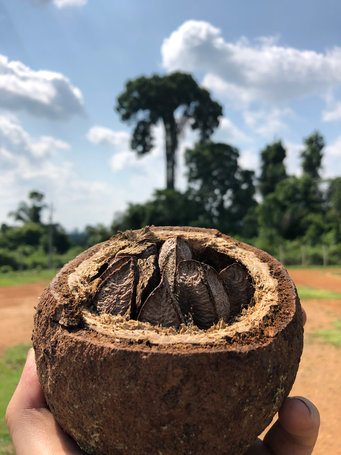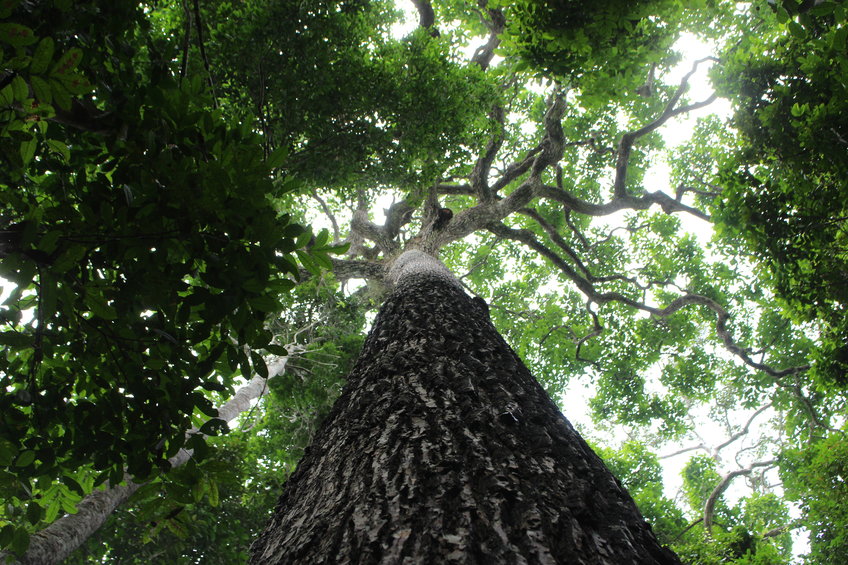Genomic analyses reveal the vital role of human activity in the Amazonian species' genetic makeup.
Researchers from the German Max Planck Institutes of Geoanthropology and Biology Tübingen use genomic data to study the decline in genetic diversity in the Amazon Basin, particularly in Brazil Nut trees. The research uses genomic data to understand this keystone species' genetic health and adaptability, help reconstruct its demographic history, and assess the long-term impacts of human interaction on forest ecosystems. The findings emphasise the need for conservation strategies to consider both ecological and anthropogenic factors.

Opened Brazil nut
© MPI of Geoanthropology / Victor Caetano-Andrade
The significant decline in genetic diversity in the Amazon Basin, following historical events such as European colonisation, deforestation and the extinction of megafauna such as the sloth - the main seed dispersal agents, is of particular concern for the genetic health of Brazil Nut trees (Bertholletia excelsa). As one of the most impacted keystone species in rainforests, Brazil Nut trees are essential for biodiversity and a vital income source for local economies.
A crucial study led by researchers from the Max Planck Institute of Geoanthropology and the Max Planck Institute for Biology Tübingen unveils critical insights into the species' genetic diversity and population dynamics, providing valuable anthropocentric and biological information for this threatened forest ecosystem.
"This research provides an amazing opportunity to study see how human actions, even in the distant past, have affected genetic makeup in a wild species over short time scales," stated Detlef Weigel, Director of the Department of Molecular Biology at the Max Planck Institute for Biology Tübingen.

Exemplary Brazilnut tree in the Amazon Basin
© MPI of Geoanthropology / Victor Caetano-Andrade
Genomic analyses reveal the importance of Indigenous management practices
Using advanced genomic techniques, the researchers comprehensively analysed total sequence variants of 270 Brazil Nut tree samples with known archaeological evidence at different locations to reveal insights into genetic structure and gene flow. The study provides detailed genomic data, including identifying over 126,000 genetic variants in Brazil Nut, providing valuable insights into the genetic health and adaptability of the species in the face of environmental changes.
The findings indicate that while the genetic diversity of Brazil Nut has drastically declined compared to other species over the last 20,000 years, while areas with a history of Indigenous management show more complex genetic backgrounds. This study reveals the connection between the plants and Indigenous land stewardship. In particular, younger trees in the protected Tefé National Forest (TEF), estimated to be under 200 years old, exhibit complex genetic backgrounds compared to other studied groups, likely due to natural disturbances and local communities' management. This genetic diversity is crucial for the species' resilience and adaptability in the face of environmental changes. Traditional ecological practices may promote the species' genetic diversity and health, providing a model for sustainable management.
Victor Caetano-Andrade, Postdoctoral researcher in the Department of Coevolution of Land Use and Urbanisation at the Max Planck Institute of Geoanthropology, explains, "We aimed to bridge gaps in our understanding of the long-term anthropogenic influences on forest ecosystems. Our findings demonstrate how Indigenous land management practices play a significant role in maintaining the genetic diversity of Brazil nut populations."
Promoting collaboration between scientists and local Indigenous land stewards and their historical ecological knowledge has the potential to create more effective and inclusive conservation policies.
Looking ahead, the researchers plan to expand their studies to include more regions and additional species within the Amazon rainforest. The goal is to develop comprehensive conservation frameworks that protect Brazil Nut trees and enhance the ecosystem's resilience.






